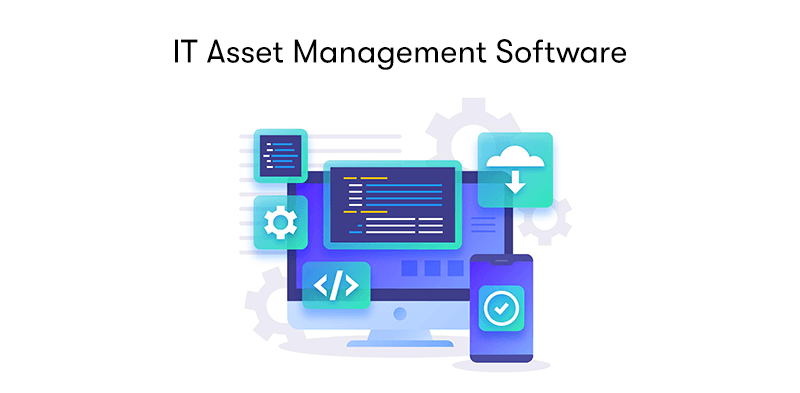IT Asset Management Software
Welcome to our in-depth exploration of IT Asset Management (ITAM) Software, a cornerstone in the modern IT infrastructure of organisations worldwide. In today's rapidly evolving technological landscape, the efficient management of IT assets – encompassing both hardware and software components – is not just a necessity but a strategic imperative.
ITAM Software emerges as a critical tool in this context, offering comprehensive solutions for tracking, managing, and optimising these assets. Through this discussion, we aim to unravel the layers of ITAM Software, shedding light on its functionalities, the significant advantages it brings and the considerations one must weigh in its implementation.
Whether you're a seasoned IT professional or new to IT asset management, join us as we delve into ITAM Software, a key driver in enhancing operational efficiency and strategic decision-making in organisations.
What is IT Asset Management Software?
IT Asset Management Software is a type of software organisations use to track, manage, and optimise the hardware and software assets within their IT infrastructure. The primary functions and benefits of IT Asset Management Software include:
Inventory Management
ITAM software helps maintain an accurate and up-to-date inventory of all IT assets, such as computers, servers, networking equipment, and software applications. This includes tracking the location, usage, and status of each asset.
Lifecycle Management
It oversees the entire lifecycle of IT assets, from procurement and deployment to maintenance, usage, and eventual disposal or retirement. This helps in optimising the usage and extending the lifespan of the assets.
License Management
For software assets, ITAM software assists in managing software licenses, ensuring compliance with licensing agreements, and avoiding legal issues related to software misuse or under-licensing.
Cost Management
By tracking and analysing the usage and maintenance of IT assets, this software aids in cost control and budgeting. It helps identify underutilised assets, which can be reallocated or retired to save costs.
Risk Management
ITAM software identifies risks associated with IT assets, such as outdated systems vulnerable to security threats, and assists in implementing measures to mitigate these risks.
Policy and Compliance Management
It ensures that the organisation's IT assets are managed in accordance with internal policies and external regulatory requirements, such as data protection laws.
Reporting and Analytics
The software provides detailed reports and analytics on IT asset usage, performance, and costs, aiding strategic decision-making.
Overall, IT Asset Management Software plays a crucial role in efficiently managing the IT assets of an organisation, optimising their use, ensuring compliance, and contributing to the overall IT strategy and business objectives.
What Are the Advantages of Using ITAM Software?
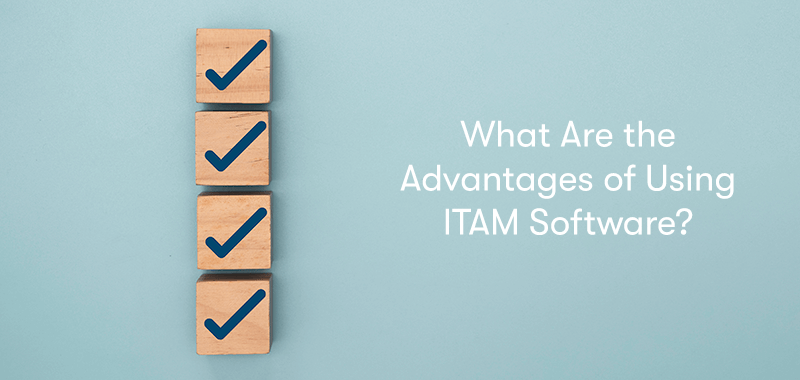
Using ITAM Software brings several key advantages to organisations, enhancing efficiency, compliance, and strategic decision-making:
Improved Asset Visibility and Control
ITAM software provides a comprehensive view of all IT assets within the organisation. This visibility enables better control and management, ensuring that assets are used effectively and are not lost, stolen, or underutilised.
Cost Savings and Financial Management
By efficiently managing assets, organisations can avoid unnecessary purchases and reduce expenses related to maintenance and support. ITAM software helps identify redundant or underused assets that can be reallocated or retired, leading to significant cost savings.
Enhanced Compliance and Reduced Legal Risks
ITAM software aids in managing software licenses and ensuring compliance with licensing agreements. This reduces the risk of legal issues and financial penalties associated with software license violations.
Optimised Asset Utilisation
Through tracking and analysing the usage of IT assets, organisations can make informed decisions about asset redistribution, purchase, and retirement, leading to optimised asset utilisation.
Risk Management and Security
ITAM software helps identify and manage risks associated with IT assets. For example, it can flag outdated hardware or software that may pose security vulnerabilities, enabling proactive measures to mitigate these risks.
Better Decision Making
The insights and analytics provided by ITAM software support strategic decision-making regarding IT infrastructure investments and upgrades. Organisations can plan more effectively for future IT needs based on accurate, real-time data.
Improved IT Service Management (ITSM) Integration
ITAM can be integrated with ITSM processes, providing a more holistic approach to managing IT services. This integration ensures that asset management is aligned with the overall IT strategy and service delivery.
Lifecycle Management
ITAM software assists in managing the entire lifecycle of assets, from procurement to disposal. This lifecycle approach ensures that assets are adequately maintained, their usage is maximised, and they are disposed of securely and environmentally friendly.
Automated Processes and Efficiency
Automation of key asset management processes reduces manual effort, minimises errors, and increases operational efficiency. Tasks like inventory tracking, compliance checks, and reporting are streamlined.
Strategic Planning Support
Access to detailed information about IT assets assists in long-term strategic planning. Organisations can forecast future needs more accurately, plan budgets, and make informed decisions about technology investments.
In summary, ITAM software is a critical tool for modern organisations. It enables them to manage their IT assets more effectively, ensure compliance, reduce costs, and make informed decisions that align with their strategic goals and operational needs.
What Are the Disadvantages of Using ITAM Software?
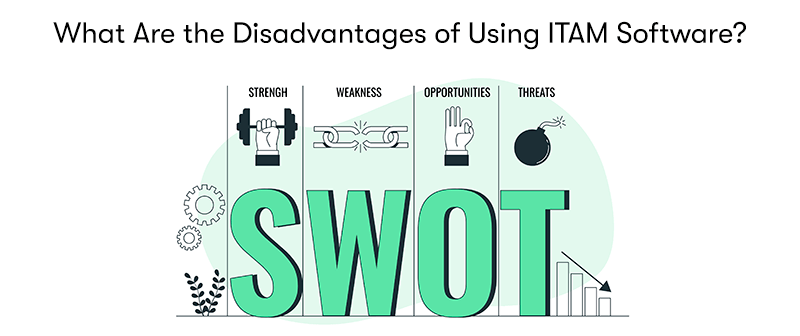
While IT Asset Management software offers numerous benefits, there are also some disadvantages or challenges associated with its use:
Cost of Implementation and Maintenance
ITAM software can be expensive to implement, especially for large organisations with extensive IT infrastructures. Additionally, ongoing maintenance, updates, and training costs can be significant.
Complexity and Learning Curve
The complexity of ITAM software can result in a steep learning curve for staff. Proper training and time are required to fully understand and effectively use the software, which can lead to delays in realising its benefits.
Integration Challenges
Integrating ITAM software with existing systems (IT service management, procurement systems, etc.) can be complex and time-consuming. Incompatibilities between systems can lead to data silos or require additional resources to ensure seamless integration.
Data Accuracy and Consistency Issues
The effectiveness of ITAM software heavily relies on the accuracy and consistency of the data it manages. Inaccurate data entry or failure to update asset information regularly can lead to poor decision-making and inefficiencies.
Overdependence on Software
There's a risk of becoming over-reliant on ITAM software for decision-making. This could lead to a lack of critical human oversight, where decisions are made solely based on software outputs without considering contextual or nuanced factors.
Privacy and Security Concerns
Managing sensitive information about IT assets, particularly those holding critical business data, raises privacy and security concerns. Ensuring that the ITAM software is secure and complies with data protection regulations is essential.
Resource Allocation for Management
Effective use of ITAM software requires dedicated personnel for its management, which can strain resources, particularly in smaller organisations that may not have the luxury of a dedicated IT asset management team.
Resistance to Change
Implementing a new system often encounters resistance from employees who are accustomed to existing processes. This resistance can hinder the successful adoption of ITAM software.
Scalability Issues
As organisations grow, their ITAM software needs to scale accordingly. Some ITAM solutions may need to be better equipped to handle rapid growth or changes in the IT infrastructure, leading to potential bottlenecks.
Potential for Unused Features
Often, ITAM software comes with a wide range of features, only some of which may be relevant or useful for some organisations. This can result in paying for functionalities that remain unused, thereby not fully realising the investment.
In summary, while ITAM software is a valuable tool for managing IT assets, organisations must carefully consider these potential disadvantages and plan accordingly to ensure they maximise the benefits while mitigating the challenges.
What Features Are Important When Picking Software for ITAM?
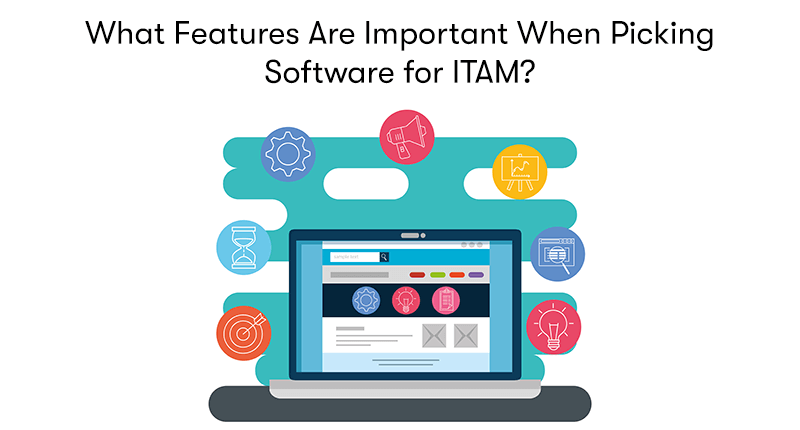
When selecting ITAM software, certain key features should be considered to ensure that the software meets an organisation's specific needs. Here are some important features to look for:
Comprehensive Asset Tracking
The software should offer robust tracking capabilities for both hardware and software assets, including the ability to track assets throughout their lifecycle, from procurement to disposal.
License Management
It should effectively manage software licenses, ensuring compliance with licensing agreements and helping to avoid penalties associated with under-licensing or non-compliance.
Integration Capabilities
The ITAM software should integrate seamlessly with other systems, such as IT service management tools, financial systems, and network monitoring solutions, to provide a unified view of IT assets.
Customisable Reporting and Analytics
It should offer customisable reporting features and analytics to help make informed decisions based on asset utilisation, performance, and lifecycle costs.
Automated Discovery and Inventory
The software should automate the process of discovering and inventorying IT assets, reducing manual work and the likelihood of errors.
User-Friendly Interface
A user-friendly and intuitive interface is crucial for easy navigation and effective use of the software by all stakeholders.
Scalability
The software should be scalable to accommodate the growth of the organisation and the corresponding increase in IT assets.
Security and Compliance Features
It should include features that help maintain security and compliance, particularly in managing sensitive data associated with IT assets.
Cost Management Tools
The software should provide tools for tracking and managing the costs associated with IT assets, including depreciation, maintenance, and other operational costs.
Support and Maintenance
Good vendor support and regular updates are essential to ensure that the software remains effective over time and adapts to changing IT environments.
Cloud-Based vs. On-Premises
Deciding between a cloud-based or on-premises solution is crucial, depending on the organisation's needs. Cloud-based solutions offer accessibility and lower upfront costs, while on-premises solutions may offer more control and customisation.
Mobile Compatibility
Accessing and managing assets via mobile devices can be a significant advantage for on-the-go asset tracking and management.
Alerts and Notifications
The system should provide timely alerts and notifications for important events related to assets, such as license renewals, maintenance requirements, or security issues.
Customisation and Flexibility
The software should be flexible and customisable to fit the specific needs and processes of the organisation.
Choosing the right ITAM software involves assessing these features in the context of the organisation's needs, size, and IT infrastructure complexity. It's also beneficial to consider future needs and how the software can scale and adapt as the organisation grows and evolves.
Do You Need Different Software for Managing Hardware and Software Assets?
In IT Asset Management, whether you need different software for managing hardware and software assets depends on your organisation's specific needs and context. Here's an overview of the considerations:
Single ITAM Solution
Integrated Approach: Many modern ITAM solutions are designed to manage both hardware and software assets within a single system. This integrated approach offers a unified view of all assets, making management more streamlined and efficient.
Cost-Effectiveness: Using a single solution for both types of assets can be more cost-effective than purchasing and maintaining separate systems.
Ease of Reporting and Analysis: An integrated system simplifies reporting and analysis, as all data is consolidated in one place. This can lead to better decision-making and strategic planning.
Separate Solutions
Specialised Needs: In some cases, the specific requirements or complexity of managing hardware or software assets might necessitate specialised solutions. For example, software asset management (SAM) can be complex, involving license compliance, version control, and usage monitoring, which might require a dedicated tool.
Scale and Complexity of IT Infrastructure: Larger organisations or those with particularly complex IT infrastructures might find that a specialised tool better meets their needs for one aspect of ITAM (either hardware or software).
Advanced Features: Specialised solutions may offer advanced features or capabilities tailored to the unique challenges of managing hardware or software, which might not be available in integrated ITAM systems.
Hybrid Approach
Best of Both Worlds: Some organisations opt for a hybrid approach, using a general ITAM solution for overall management but supplementing it with specialised tools for specific tasks or complex assets.
Flexibility: This approach provides flexibility and allows organisations to leverage the strengths of each type of tool.
Considerations for Decision Making
Assess Your Needs: Evaluate the specific needs of your organisation in terms of asset types, volume, complexity, and any unique requirements.
Budget Constraints: Consider your budget for ITAM solutions, as implementing and maintaining multiple systems can be more expensive.
Integration Capabilities: If you choose separate solutions, ensure they can integrate well to provide cohesive data and reporting.
Future Scalability: Think about how your organisation might grow and how your ITAM needs might evolve. A scalable and adaptable solution can be more beneficial in the long run.
In summary, whether to use separate software solutions for managing hardware and software assets depends on your organisation's unique needs, scale, and budget. An integrated ITAM solution is often sufficient and more cost-effective for many organisations, but larger or more complex environments might benefit from specialised or hybrid approaches.
What is IT Asset Management and Why is it Important?
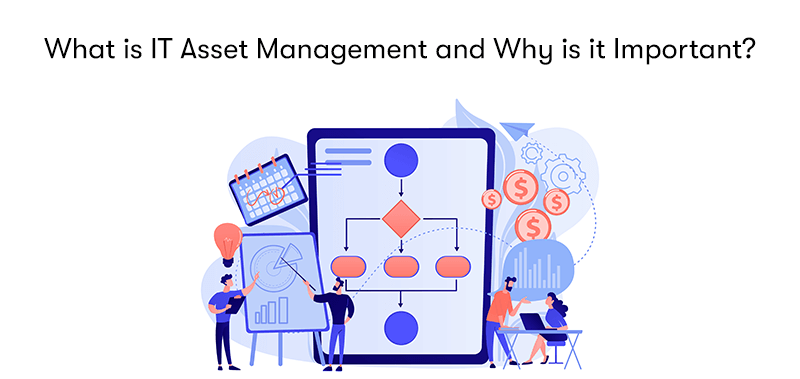
IT Asset Management is a set of business practices that incorporates IT assets across the business units within the organisation. It combines financial, inventory, and contractual functions to support lifecycle management and strategic decision-making for the IT environment. The assets typically include all elements of software and hardware found in the business environment. Here are some key areas of the Importance of IT Asset Management:
Cost Management
ITAM helps identify and eliminate wasted or underutilised resources, thereby reducing costs. By effectively managing assets, organisations can avoid over-purchasing or underutilising existing assets.
Lifecycle Management
It oversees the entire lifecycle of IT assets, from procurement to disposal. This ensures that assets are optimally used throughout their lifecycle and replaced or upgraded at the right time, enhancing efficiency.
Compliance and Risk Management
Proper ITAM practices ensure compliance with various licensing agreements and regulations, reducing the risk of legal issues and financial penalties. It also helps identify and mitigate risks associated with using outdated or unsupported hardware and software.
Strategic Planning
Organisations can plan future investments more effectively with comprehensive knowledge of the existing IT assets. ITAM provides valuable data that informs decisions about IT infrastructure changes or upgrades.
Enhanced Productivity
By ensuring that employees have the right tools at the right time, ITAM contributes to improved productivity. It also reduces downtime by ensuring timely maintenance and upgrades of IT equipment.
Security
Effective asset management helps in maintaining a secure IT environment. By keeping track of all assets and ensuring they are updated and patched, organisations can better protect against cybersecurity threats.
Improved Vendor Management
ITAM involves managing relationships with various vendors, ensuring that the organisation gets the best value from its contracts and that vendor performance aligns with expectations.
Asset Visibility and Control
ITAM provides a clear view of the organisation's assets, where they are, and how they are being used. This visibility is crucial for controlling costs, managing inventory, and making informed decisions.
Optimised Resource Allocation
By understanding the usage and performance of IT assets, organisations can allocate resources more effectively, ensuring that every asset is put to its best use.
Environmental Compliance
ITAM also involves the responsible disposal or recycling of IT equipment, helping organisations comply with environmental regulations and policies.
In conclusion, IT Asset Management is vital for maximising the value of IT investments, ensuring compliance, enhancing operational efficiency and supporting strategic decision-making within an organisation.
Final Notes on ITAM Software
In conclusion, our exploration of IT Asset Management has highlighted its crucial role in modern organisational structures. From understanding the basics of ITAM software, its advantages and potential drawbacks to delving into the vital features to look for when selecting such software, we've covered a comprehensive spectrum.
Whether you require different software for managing hardware and software assets or seek to understand ITAM's overall importance, it's clear that this practice is integral to optimising asset utilisation, ensuring compliance, and driving strategic decision-making.
As we wrap up, remember that the choice of ITAM solutions should align with your organisation's specific needs, balancing cost, complexity, and functionality to harness the full potential of your IT infrastructure.


